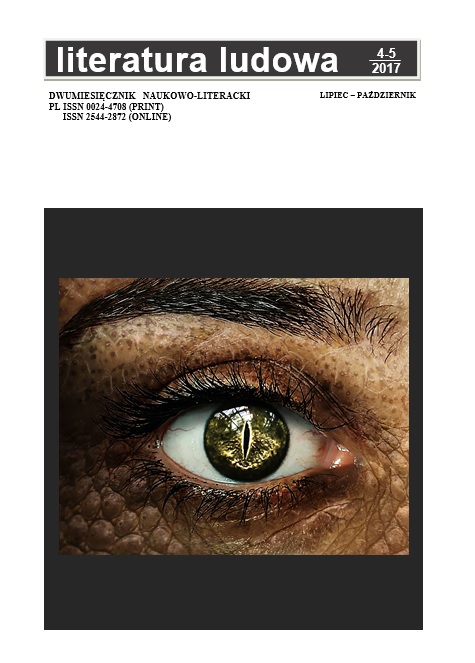SHERLOCK HOLMES, A MANGLE AND A MEANINGLESS RITUAL: THE DEMONIC (OF) REPETITIONS IN POPULAR CULTURE
DOI:
https://doi.org/10.12775/LL.4-5.2017.004Keywords
the demonic, popular culture, repetition, ritual, horror, the uncannyAbstract
The article focuses on the mechanism of repeating a formula in texts of popular culture and its relations to evoking the experience of the uncanny (uncheimlich) in the process of reception of popular narratives, both those alluding to the aesthetics of horror and those following other conventions (crime fiction, comedies, etc.). The essence of this experience is the audience’s discovery of (un-)expected repetitions of the same in something seemingly different, that is, an identical formula in a new, yet unknown, text. The methodological context for this analysis consists of J.G. Cawelti’s concept of formula, Freud’s theory of “the uncanny”, Harold Bloom’s concept of the anxiety of influence, and Frits Staal’s notion of “the meaningless ritual”. The texts analyzed herein are short stories by Stephen King, Arthur Conan Doyle, and Clive Barker as well as TV series Friends and Big Bang Theory.
References
BARKER, C. (1992). Powrót z piekła (przeł. P. Kwiatkowski). Poznań: Rebis.
BLOOM, H. (2002). Lęk przed wpływem. Teoria poezji (przeł. A. Bielik-Robson, M. Szuster). Kraków: Universitas.
BOURDIEU, P. (2007). Szkic teorii praktyki poprzedzony trzema studiami na temat etnologii Kabylów (przeł. W. Kroker). Kęty: Wydawnictwo Marek Derewiecki.
BRZOSTEK, D. (2001). Przełamywanie schematu. Parodia jako zabieg dekonwencjonalizujący w literaturze popularnej, na przykładzie science fiction. „Acta Universitatis Nicolai Copernici”, Filologia Polska LVI.
BRZOSTEK, D. (2005). Między Baker Street 221/B a Berggasse 19, czyli o detektywach i psychoanalitykach. W: M. Cyzman i K. Szostakowska (red.), Z filozoficznych inspiracji literatury. Toruń: Interdyscyplinarne Koło Naukowe Doktorantów Uniwersytetu Mikołaja Kopernika.
BRZOSTEK, D. (2009). Literatura i nierozum. Antropologia fantastyki grozy, Toruń: Wydawnictwo Naukowe UMK.
BRZOSTEK, D. (2013). Analiza tekstu, interpretacja zbrodni. O wartościach poznawczych fikcji detektywistycznej. W: T. Dalasiński i T. Markiewka (red.), Kryminał – gatunek poważ(a)ny? Poznań: „ProLog” Interdyscyplinarne Czasopismo Humanistyczne.
CARROL, N. (2004). Filozofia horroru albo paradoksy uczuć, przeł. M. Przylipiak, Gdańsk: Słowo/Obraz Terytoria.
CAWELTI, J. G. (1973). Koncepcja schematu w badaniach literatury popularnej (przeł. M. Dzieduszycka). „Literatura Ludowa”, nr 6, s. 44-52.
DOYLE, A. C. (2007), Rytuał Musgrave’ów. W: tenże, Zagadki Sherlocka Holmesa (przeł. T. Evert). Warszawa: Oficyna Wydawnicza Rytm.
ECO, U. (1996). Struktury narracyjne u Fleminga. W: tenże, Superman w literaturze masowej. Powieść popularna – między retoryką a ideologią (przeł. J. Ugniewska). Warszawa: PIW.
FREUD, S. (1997). Niesamowite. W: tenże, Pisma psychologiczne (przeł. R. Reszke). Warszawa: Wydawnictwo KR.
FREUD, S. (2001). Zahamowanie, symptom i lęk. W: tenże, Histeria i lęk (przeł. R. Reszke), Warszawa: Wydawnictwo KR.
KING, S. (2007). Magiel. W: tenże, Nocna zmiana (przeł. M. Wroczyński). Warszawa: Prószyński i Spółka.
LAPLANCHE, J., Pontalis, J.-B. (1996). Słownik psychoanalizy (przeł. E. Modzelewska, E. Wojciechowska). Warszawa: Wydawnictwa Szkolne i Pedagogiczne.
LASIĆ, S. (1976). Poetyka powieści kryminalnej (przeł. M. Petryńska). Warszawa: PIW.
LOVECRAFT, H. P. (2012). Zew Cthulhu. W: tenże, Zgroza w Dunwich i inne przerażające opowieści (przeł. M. Płaza). Poznań: Vesper.
MANN, T. (1972). Czarodziejska góra (przeł. J. Kramsztyk). tom 1, Warszawa: Czytelnik.
MANN, T. (1974). Der Zauberberg. Roman. Frankfurt am Main: S. Fischer Verlag.
NOWICKA, O. (2015). Miarą ofiary jest człowiek. Antropometria w wedyjskim rytuale ofiarniczym śrauta, „Studia Religiologica”, 48 (1), s. 35-47.
SMUSZKIEWICZ, A. (1980). Stereotyp fabularny fantastyki naukowej. Wrocław: Zakład Narodowy im. Ossolińskich.
STAAL, F. (1979). The Meaningless of Ritual, „Numen”, nr 26, s. 2-22.
Wróblewska, V. (2014). Od potworów do znaków pustych. Ludowe demony w polskiej literaturze dla dzieci. Toruń: Wydawnictwo Naukowe UMK.
Downloads
Published
How to Cite
Issue
Section
License
1. The authors give the publisher (Polish Ethnological Society) non-exclusive license to use the work in the following fields:a) recording of a Work / subject of a related copyright;
b) reproduction (multiplication) Work / subject of a related copyright in print and digital technique (ebook, audiobook);
c) marketing of units of reproduced Work / subject of a related copyright;
d) introduction of Work / object of related copyright to computer memory;
e) dissemination of the work in an electronic version in the formula of open access under the Creative Commons license (CC BY - ND 3.0).
2. The authors give the publisher the license free of charge.
3. The use of the work by publisher in the above mentioned aspects is not limited in time, quantitatively nor territorially.
Stats
Number of views and downloads: 301
Number of citations: 0



